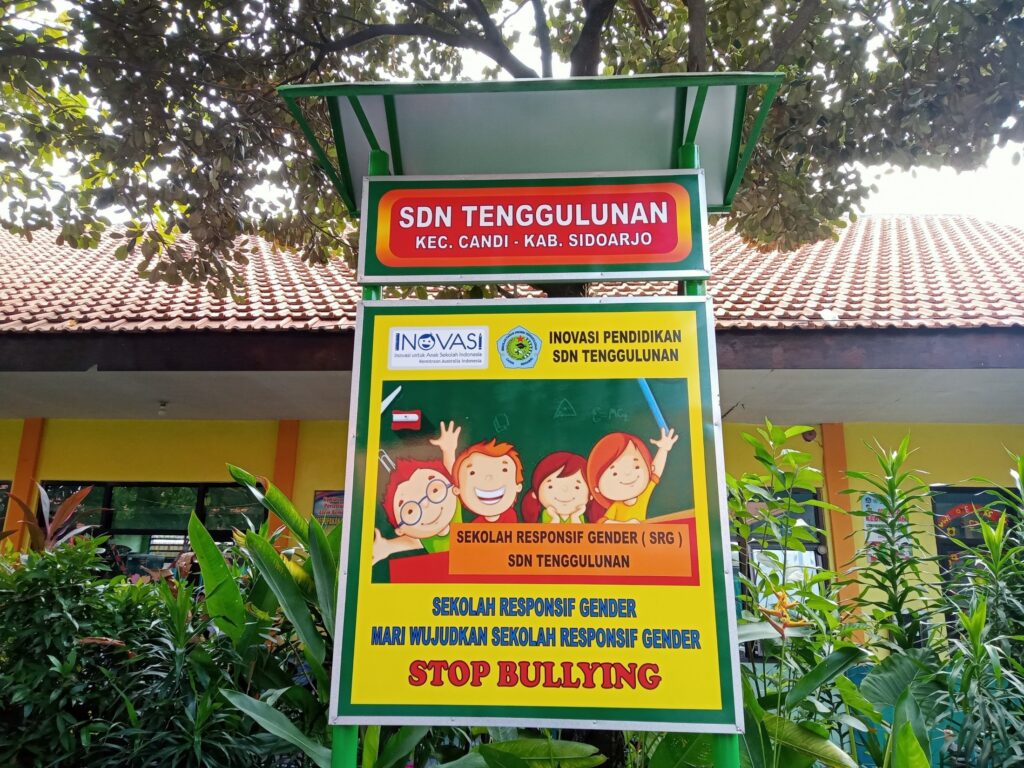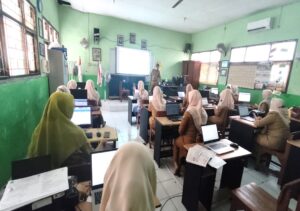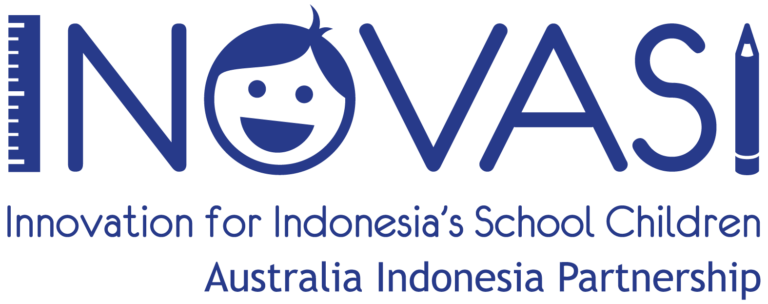
Gender Responsive School (SRG) is a partnership program between INOVASI and the Study Centre for Gender and Child Protection (PSGPA) of the Universitas Muhammadiyah Sidoarjo (UMSIDA), aiming to strengthen the understanding of gender equality in education. In development, the gender issue is one of the main concerns – especially in terms of human resource development. For this reason, through a program in the form of training and assistance carried out in 10 primary schools in Sidoarjo, East Java, this effort is expected to prepare teachers and education personnel to integrate gender equality in schools.
Since 2022, the Gender Responsive School (SRG) program has been implemented in Sidoarjo, East Java. There are 48 trainees in this program, consisting of principals, teachers, and staff (38 Female, 10 Male). Those trainees come from 10 primary schools in Sidoarjo, namely SDN Larangan, SDN Tenggulunan, and SDN Kedungkendo; Medium Category: SDN Sepande, SDN Sumokali, SDN Sidodadi, and SDN Durung Banjar; and Low Category: SDN Durung Bedug, SDN Jambangan, and SD Muhammadiyah 1 Candi Labschool UMSIDA. The following is the inspiring story of a principal from a program partner school who once was a teacher for 27 years.
Principal Realising a Gender-Responsive School
Dra. Anis Mufidah, M.Pd (59), the principal of SDN Tenggulunan, Sidoarjo, East Java, has implemented the principles of Gender-Responsive Schools (SRG) in her school. Before starting her career as a principal, Anis was a teacher with 27 years of experience. As a school principal, there were four schools that she has led.
“I graduated from IKIP PGRI Kediri in 1983. After graduation, I worked as a teacher at SD Sugihwaras, Sidoarjo. For 27 years being a teacher, I taught all subjects for fifth & sixth-grade students. One of the unforgettable experiences during my time as a teacher was when I introduced the students to national songs. Every Saturday, I used to go to all classes to tell and teach the national song that would be sung on Monday for the flag ceremony. The class teacher in each class would continue teaching the national song I had taught so that during the flag ceremony, the teachers and students could sing the song. I can never forget this experience of introducing these children to the national songs and helping them build the sense of belonging to Indonesia.” – Dra. Anis Mufidah, M.Pd, the Principal of SDN Tenggulunan, Sidoarjo
SDN Tenggulunan was established in 1997 in the centre of Sidoarjo Regency, adjacent to the traditional market. Most merchants around the traditional market are Madurese, and most of the students in the school are the children of the merchants in that traditional market. There are 467 students at SDN Tenggulungan, consisting of 229 female students and 238 male students, and the number of education personnel is 21 teachers, consisting of 19 female teachers and 2 male teachers.
Through the cooperation program between INOVASI and UMSIDA, the participants were provided with a briefing on the significance of gender-responsive schools so they could integrate this issue into the School Work Plans (RKS) and the Learning Implementation Plan (RPP). Gender-responsive school principles in the RKS included school management, school sanitation, school policies, and school budgets allocated for gender responsiveness. Meanwhile, the RKS includes how gender issues are integrated with the RPP design and the practice of gender responsiveness in classroom teaching.
According to Anis, she felt lucky to manage to attend the gender-responsive school training, and her understanding has increased. “Gender responsiveness has actually been practised in the school I lead. Let’s take distributing equal tasks for both female and male students, for example. SDN Tenggulunan also has adequate facilities and infrastructure, like a sufficient number of toilets for the students and teachers, school health units, and other facilities. It’s just that the gender-responsive function has not been paid much attention to. The teachers’ learning activities in the classroom are implemented without considering gender equality between female and male students. Curriculum documents, lesson plans, teaching materials, and media and learning assessments remain not gender-responsive based,” explained Anis.
Anti-Bullying Team at SDN Tenggulunan
How do we manage a school to implement gender-responsive school principles? Anis and the team of educators at SDN Tenggulunan have used their best endeavours to realise this, including by 1) allocating a gender-responsive budget, 2) developing lesson plans and integrating SRG in the classroom teaching, 3) establishing several SRG Policies, i.e., SRG policy, SRG management policy, SRG assessment policy, school infrastructure improvement policy, and 4) forming the anti-bullying team and the SRG assessment monitoring and evaluation team.
Aspects that remain challenging for Anis and the teachers in the school are the lack of discipline as well as bullying actions, which are still practiced among students, both in the classroom and the school environment. To overcome this, Anis and the teachers formed an anti-bullying team that is gender-responsive. The team comprises the principal as the coach, one of the teachers as the chairperson, and other teachers as the members.
Bullying is an ongoing and deliberate misuse of power in relationships through repeated verbal, physical and/or social behaviour that intends to cause physical, social and/or psychological harm. It can involve an individual or a group misusing their power, or perceived power, over one or more persons who feel unable to stop it from happening. Bullying can happen in person or online, via various digital platforms and devices and it can be obvious (overt) or hidden (covert). Bullying behaviour is repeated, or has the potential to be repeated, over time (for example, through sharing of digital records)[1]. Gender-based bullying can be in the form of sexual harassment or discrimination on sexual orientation, be it suggestive comments or jokes, insults or taunts, pictures, emails or texts sent by bullies as well as intrusive questions about students’ personal lives. SDN Tenggulunan formed the Anti-Bullying Team so that gender-based bullying does not occur.

Photo: The anti-bullying team meeting
The anti-bullying team was formed on May 29, 2022, after the training held by INOVASI and UMSIDA. Since then, the anti-bullying team has worked together effectively in dealing with student fights or conflicts. The team held a discussion about the misbehaviour of students at the school. The team approached the students bullying their friends, including those who frequently spoke disrespectful words to their friends. Sometimes the bullying team asked some students to come to a room to talk. The team also attempted to communicate the students’ conflicts to their respective custodians or parents through a WhatsApp group.
Anis assumed that fights or bullying were common as they were still children. Sometimes they mocked each other by saying,” you’re skinny!” “you’re fat! “, “you’re stupid!”, or “you’re a brat!”. However, the bottom line is that such a mockery may provoke conflict.
“Well, this is what we anticipate so that, from the beginning, children know that making fun of their friends is not good. We approach them so they won’t do that,” said Anis.
The positive impact is that since the anti-bullying team worked with the school committee and approached the children, SDN Tenggulunan has become more peaceful, with no bullying cases. What a positive thing that the principal has initiated!
[1] https://bullyingnoway.gov.au/understanding-bullying






